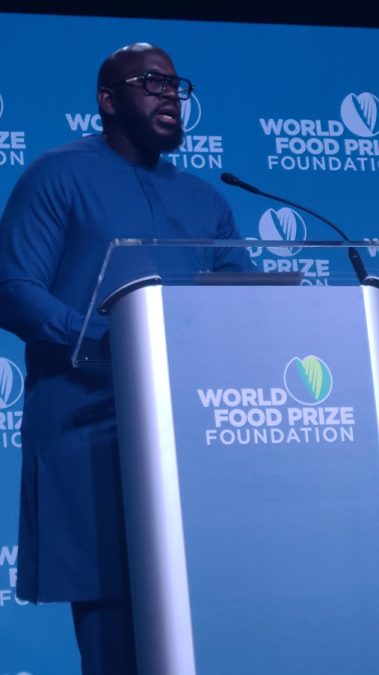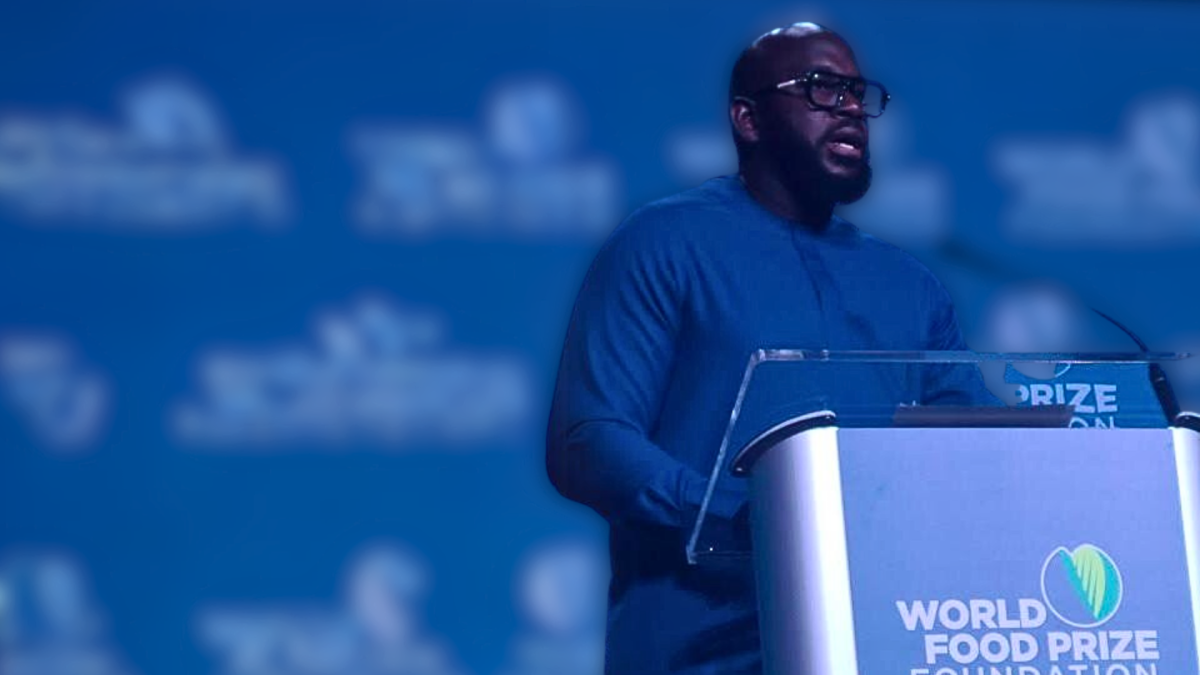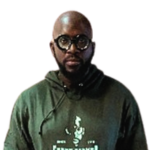Rotimi Williams, a member of the Global Farmer Network and an indigenous farmer from one of Nigeria’s conflict areas, set out to produce the most important staple in the country – rice – eleven years ago. He spoke with Farming First about his background, the challenges of farming during conflicts, how farming is supporting his community amidst insecurity and more at the World Food Prize Foundation’s 2023 Borlaug Dialogue.
Farming First (FF): Tell us a bit more about yourself and your farm.
Rotimi Williams (RW): I am a rice farmer. I have 45,000 hectares of land in Nasarawa State, and I also farm with the Nigerian Army on 3,000 hectares in Plateau State.
We have been farming for over a decade and focus on rice. In my country, there was no one farming on that scale, no single individual farming on that scale, until I started in 2012.
FF: What are the main challenges you face in running your farm today?
RW: There are the normal issues you face as a farmer: access to funding and equipment and community issues. Which is just basically getting the community to work with you or work together with other communities. However, I would say that the biggest issue today is insecurity — the threat of kidnapping or being killed on the farm.
I cannot even wake up in the morning and decide to go to my farm because I do not know if I will come back. That is a form of anxiety that nobody should go through, especially if you are trying to produce food that the world needs.
FF: How are you addressing these challenges?
RW: I understand the problem, being a farmer and working closely with the communities, which means I understand that the main issue is a communication gap. Rural communities are completely detached from the centre of the system and security agencies.
We thought this was simple. We are going to create an app that connects these two groups — the rural communities and the security agencies — such that when a button is activated, all relevant parties get the alert and can respond.
We started the pilot in 2019. It was supposed to be a four-week pilot, but from the second week of launching, we started getting alerts. From that moment in 2019 to today, we have not been able to stop the pilot. We had to go full-fledged in that community.

FF: Have you seen the community around you mobilize in support of the work you are doing?
RW: A hundred per cent. It has gotten to a point where there is a lack of trust between the community and security agencies because of historical issues. We, as a neutral party, stepped in. [The community] felt they could talk to us. If there’s anything, even if there is an imminent attack or they believe that something does not look right, immediately, they push the alert. We jump on a call and get the army to help them. Even if it turns out there is nothing, I get the army to go there. So there is that trust that we’ve built.
Off the back of the data we collect, both quantitative and qualitative data, we are able to extract certain bits of information, like the time of attack. Over a period of time you begin to see a trend; the frequency of attack, the location of attack, the mode of movement and the weapons they use. We recently found out that during an ambush, they usually use machetes because it is quiet, so nobody in the other communities can hear. If it is a full-on attack, they use AK-47s. So, you begin to see how they attack this village and if there is a method to it. We are able to debunk and unpack all these things and create a report that we give to the security agency.
We also do something called a root cause analysis, because we also understand that for every community in rural areas, you are presented with a different problem. So, you need to be able to unpack each of those villages, understand what the real issues are in each one of them and deal with them accordingly. Otherwise, the issue is going to persist.
FF: What additional support do you most need to keep this work going strong?
RW: I think we need increased research and development. In most rural areas, there may be no network, and no cell coverage. There’s a company in the United States called Swarm. It works like Starlink, except that you only push data. So, we bought a couple of those devices, which we are testing. Now, the next phase of testing is to understand how we can put them in communities and ensure that they are not vandalised or stolen.
We also look at things like trail cameras to capture the movement of people in and out of certain areas to see the trend of movement. For instance, if an attack happens tonight, how many people moved into the area? It might be a hundred people in a day, and that can tell us that type of move is an attack.
We also provide coordinates so that when they push the panic alerts, it generates the coordinates of the area so that drones can go in before the ground troops inspect the area. Then we also use drones for the surveillance of the most dangerous time to be on a certain route.
It has been hard to get the attention of the government, especially because the region we work in is so deep in the rural areas. This is also part of the cause of the rural-to-urban migration. People are in search of a better life. If they cannot go to their farms, they are going to go to the cities to get jobs.
But what does that mean for food insecurity? It means there are fewer people producing because 95 per cent of the food we consume is produced locally in rural areas. Anything that affects the rural area directly affects the food supply.
FF: What are your aspirations for your farm and the wider Nasarawa community in the future?
RW:I just want to continue farming. I want to see the dream come true where I’m farming on a large scale and every community and every farmer around me is moving up in terms of the land and their capacity.
FF: Is there anything else you would like to add?
RW: Our work is just self-funded. We developed this entire system with our money. To the point where we even started paying the hospital bills of victims. We started funding the hospital with basic supplies like paracetamol, bandages, and antiseptics. We cannot continue with our money alone. We need funding to build the next layer of the app.
For instance, we have already developed this app to deal with conflict, but after everything settles, what happens? There’s an economic element to add to it, which is the marketplace. Each farmer can now post what they are planting and see who wants to buy their crops, even before they harvest and anyone who wants to buy can do that as well.
It also allows the farmers to map their farms so we can see the area they are working on this year if they expand and their estimated production. Then, when it is time for policies on input supplies and aid to rural areas, we can do it effectively. We know what to give to who and we can monitor what we are giving out.
But the number one on the priority list is to stop the killings.



